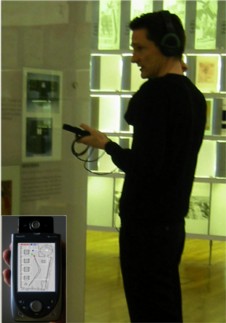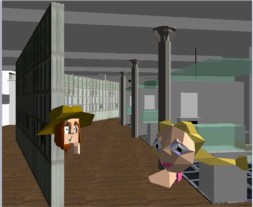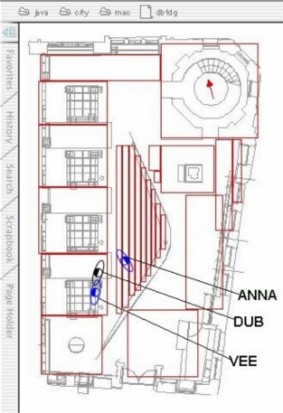| |
 The City project explores new forms of interaction for visitors to a museum or city centre. As mobile phones and computers become more complex, the range of people and places that have an effect on our moment-by-moment use of the city is expanding. We focus on bridging or blurring the boundaries between locally specific interaction and remote collaboration, using systems that mix ubicomp technology, digital maps, virtual environments and hypermedia.
The City project explores new forms of interaction for visitors to a museum or city centre. As mobile phones and computers become more complex, the range of people and places that have an effect on our moment-by-moment use of the city is expanding. We focus on bridging or blurring the boundaries between locally specific interaction and remote collaboration, using systems that mix ubicomp technology, digital maps, virtual environments and hypermedia.
City treats the city and information in a way that
deliberately blurs the boundaries between old and new
media. What makes a city meaningful to us is not just its bricks
and mortar, but also our understanding and use of it. Our use of maps, texts and images of a city influence our activity in it and our interpretation of it.
Within this Equator IRC project, researchers from
Glasgow
, Bristol
, UCL
, Nottingham
and
Southampton
are working on theory, field studies and systems design.We are exploring ways that people
can interact and maintain awareness of each other, even though
they may be spatially separated and using a variety of interactive media. Theoretical work considers the relationship between new and traditional media, and how system design might change to interweave media in order to support social interaction and interpretation. Field studies of cultural institutions have helped us understand the potential settings of use of our systems, and raised many design issues. And, of course, we have been building and experimenting with systems.
 We recently carried out user trials of a system involving three visitors to the Mackintosh Interpretation Centre, which is in the Lighthouse Centre in Glasgow. The
hypermedia and VR users were in other rooms, out of sight (and sound) of the 'Mack Room'. One person used a mobile computer (see the picture above right), and had his or her
position in the room tracked via U. Bristol's ultrasonics. The second
visitor used text and 3D VR-style graphics. The second image shows a VR visitor's view of the Centre, with co-visitors shown as simple avatars. The third visitor used text and 2D graphics. Hypermedia documents were automatically delivered
based on a visitor entering a zone or location in the room. The image, below right shows the third visitor's map of the room, with zones and co-visitors' locations highlighted. Each
person can speak with the others, and each is shown the others' locations on a map or in the VR.
We recently carried out user trials of a system involving three visitors to the Mackintosh Interpretation Centre, which is in the Lighthouse Centre in Glasgow. The
hypermedia and VR users were in other rooms, out of sight (and sound) of the 'Mack Room'. One person used a mobile computer (see the picture above right), and had his or her
position in the room tracked via U. Bristol's ultrasonics. The second
visitor used text and 3D VR-style graphics. The second image shows a VR visitor's view of the Centre, with co-visitors shown as simple avatars. The third visitor used text and 2D graphics. Hypermedia documents were automatically delivered
based on a visitor entering a zone or location in the room. The image, below right shows the third visitor's map of the room, with zones and co-visitors' locations highlighted. Each
person can speak with the others, and each is shown the others' locations on a map or in the VR.
Here's a movie (57MB!) recorded from the trial, showing a trial participant meeting up with her two remote co-visitors. What was interesting for us is how visitors changed from a focus on the novel tools and technologies, to engaging with the exhibition and the 'task' of a shared visit. You can see the difference in this video segment where three visitors discuss their favourite image.
 At the moment, we are reconfiguring the system to cover more of the city, to offer asynchronous awareness between visitors, and to better support disconnection and uncertainty in communications and positioning systems. We continue to do field studies of city visitors, and to work on theoretical issues such as seamfulness: design that takes full account of the inevitable uncertainty and inaccuracy of modelling.
At the moment, we are reconfiguring the system to cover more of the city, to offer asynchronous awareness between visitors, and to better support disconnection and uncertainty in communications and positioning systems. We continue to do field studies of city visitors, and to work on theoretical issues such as seamfulness: design that takes full account of the inevitable uncertainty and inaccuracy of modelling.
The project has been supported by a substantial equipment
donation by Equator industrial partner, Hewlett-Packard, through
its
Art & Science
philanthropy programme.
The City project has been described in detail in over 30 papers, including:
-
Can You See Me?: Exploring co-visiting between physical and virtual visitors,
Galani and Chalmers, Proc. Museums and the Web 2002.
-
Shared visiting in EQUATOR City,
MacColl et al.
Collaborative Virtual Environments 2002.
-
Awareness, Representation and Interpretation,
Chalmers, Journal of CSCW, vol. 11, 2003, pp. 389-409.
-
Lessons from the Lighthouse: Collaboration in a shared mixed reality system,
Brown, MacColl, Chalmers, Galani, Randell and Steed, Proc. ACM CHI 2003 pp. 577-584.
|




